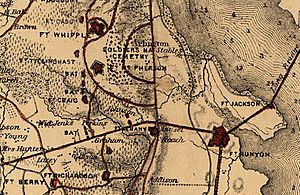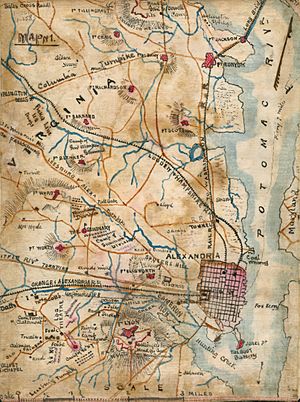Fort Tillinghast facts for kids
Quick facts for kids Fort Tillinghast |
|
|---|---|
| Part of the Civil War defenses of Washington, D.C. | |
| Arlington County, Virginia | |

Map of Fort Craig and surrounding area including Fort Tillinghast, 1865.
|
|
| Coordinates | 38°52′43″N 77°05′02″W / 38.8785000°N 77.0838333°W |
| Type | Earthwork fort |
| Site information | |
| Controlled by | Union Army |
| Condition | Residential Area |
| Site history | |
| Built | 1861 |
| Built by | U.S. Army Corps of Engineers |
| In use | 1861–1865 |
| Materials | Earth, timber |
| Demolished | 1865 |
| Battles/wars | American Civil War |
Fort Tillinghast was a small fort built by the Union Army during the American Civil War. It was located in what is now Arlington County, Virginia. This fort was an important part of the defenses that protected Washington, D.C. from attacks. It stood close to Arlington House, which was the home of Confederate General Robert E. Lee.
Contents
What Was Fort Tillinghast?
Building the Fort
After the Union Army faced a tough defeat at the First Battle of Bull Run in July 1861, they quickly started building forts. Fort Tillinghast was one of these forts, built in August 1861. It was a type of fort called a "lunette." A lunette is a small, crescent-shaped fort. It was part of a line of forts called the Arlington Line.
Fort Tillinghast was connected to other forts nearby. It was about 0.6 miles (1 km) south of Fort Craig. It was also about 0.3 miles (0.5 km) north of Fort Cass. Along with other forts like Fort Woodbury, Fort Morton, and Fort Strong, it helped guard important bridges. These bridges included the Long Bridge and the Aqueduct Bridge. Today, the Aqueduct Bridge is near the modern Key Bridge.
Who Was It Named After?
The fort was named to honor Captain Otis H. Tillinghast. He was a Quartermaster in the Union Army. Sadly, he was killed during the First Battle of Bull Run on July 21, 1861.
What Was Inside the Fort?
Fort Tillinghast faced west, ready to defend against attacks from that direction. It had a perimeter of about 298 yards (272 meters). This means the outer edge of the fort was that long. The fort was designed to hold 12 guns. It also had two magazines, which were safe places to store ammunition. There was also a "bomb-proof" area. This was a strong shelter designed to protect soldiers from exploding shells.
The fort had many different types of cannons. These included four 24-pound guns and one 24-pound field howitzer. It also had four 30-pound Parrott rifles and two 20-pound Parrott rifles. For closer range, it had two 24-pound Coehorn mortars.
Several Union Army units were stationed at Fort Tillinghast. These included the 16th Maine Infantry and the 1st Massachusetts Heavy Artillery. Other units were the 4th New York Heavy Artillery and the 145th and 138th Ohio Infantry.
Life at the Fort
In May 1864, a report was made about Fort Tillinghast. Major Rolfe was in charge of the fort at that time. The report said that two companies of the First Massachusetts Heavy Artillery were stationed there. This meant about 7 officers and 220 soldiers.
The report also listed the fort's weapons. It noted that the magazines were being rebuilt. This meant ammunition had to be kept in the bomb-proof shelter for a while. The report said the fort had a full supply of ammunition. The tools for the guns were also in good condition. The soldiers were trained well in both artillery (using cannons) and infantry (foot soldiers) drills. The report concluded that the fort had enough soldiers to do its job.
What Happened to the Fort?
After the Civil War ended, Fort Tillinghast was no longer needed. In June 1865, the fort was ordered to be taken apart. The land was then given back to its original owners.
Today, no parts of Fort Tillinghast remain. The area where it once stood is now a residential neighborhood. It was near 205 North Wayne Street in Arlington. You can find a historic marker near the intersection of Arlington Boulevard (U.S. 50) and North 2nd Street in Arlington. This marker shows where the fort used to be. It also has a map of the city's defenses. The marker states that a model of Fort Tillinghast can be seen at the Hume School museum. This museum is run by the Arlington Historical Society.
Images for kids
- National Park Service - A Historic Resources Study: The Civil War Defenses of Washington



